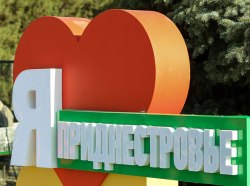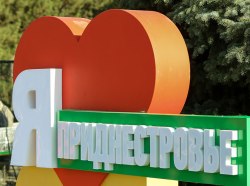There are states which you cannot find on a majority of world political maps. At the same time, they have their own territory, inhabited by people, their governmental bodies and armed forces. New states are proclaimed when the people living on a certain territory cannot live any longer within a single state due to various reasons. One of such states is the Pridnestrovian Moldavian Republic, which was formed as a result of the implementation of peoples' rights for self-determination by separating the Dniester's left bank regions from the Republic of Moldova.
The Pridnestrovian land used to be part of different states: the Golden Horde and the Polish-Lithuanian Commonwealth, the southern part was part of the so-called Wild Fields. Throughout the history the multinational population has lived here. Its composition became even more varied owing to the Russian Empire's policy encouraging the colonisation of the region by foreigners. The wide array of nationalities living in Pridnestrovie included Russians, Moldavians, Ukrainians, Bulgarians, Tatars, Germans, Jews, Greeks, Armenians, Belarusans, Swiss, Serbs, Gypsies and others. And no nation could consider itself a dominant ethnic group on this land. All this created prerequisites for the formation of the Pridnestrovian regional identity.
During Soviet times the borders between Soviet republics were merely administrative, which under the common political regime smoothed problems and conflicts. Another important factor reducing possible ethnic tensions was the policy of the union centre aimed at establishing «a new historical group of people — the Soviet nation».
When the nationalists came to power in Moldova, demanding the creation of a mononational state with only one official language, this threatened to lead to the discrimination of national minorities. It is natural that such ideas met disapproval and protest on the Dniester's left bank. The establishment of Pridnestrovie's statehood and declaration of independence, on the one hand, was the way of protecting left bank residents' rights and, on the other hand, contributed to the consolidation of a polyethnic Pridnestrovian society.
Having exhausted all opportunities to break down the resistance of the left bank population by administrative pressure and police forces, Moldova launched a military aggression. Pridnestrovians took up arms to defend their land. Many expected then that Pridnestroive would face an internal split: the Mpldovans, who made up 31% of its population, would support Kishinev and the Moldovan army, the Ukrainians and other nationalities would leave for other countries and would not prevent the Russian population from being pushed away. But there was no split. Moreover, the armed aggression mobilised Pridnestrovie's all nationalities to defend their land. It is during this period when the Pridnestrovian regional identity first showed itself. Russian journalist Efim Bershin, an eyewitness of those tragic events, quotes in his book a dialogue with a Pridnestrovian militiaman:
«What's your nationality?»
«Pridnestrocian.»
"What is it?"
«Like that. There is a mixture of six or eight bloods in me. I don't remember exactly. Moldavian, Ukrainian, Greek and, probably, Jewish. I don't remember. And I don't care. I am Pridnestrovian. And I can speak several languages. Russian, Ukrainian or Moldavian. No problem.»
Pridnestrovie began to live its own, though non-recognised, but independent, life. After peace was restored in Pridnestrovie, there was no ethnic split. The regional identity preserved its strongest traits. It may have been the result of a smouldering military threat from Moldova or the uniting Pridnestrovian idea whose essence is to struggle for recognition and defending the right to choose. The sense of a «besieged fortress» has also contributed to the consolidation of people of different nationalities into the one group of people — Pridnestrovians.
The project I'm Pridnestrovian, launched in 2014 and currently underway, finds response and support from people. The festivals which are held as part of the project attract representatives of various nationalities who say together: «I'm Pridnestrovian.» It is especially evident among the youth, who were borne and has grown up in Pridnestrovie. The anthem of one of Pridnestrovian youth organisations has the following lines: «We are young, brave and ready to fight! And proudly call ourselves Pridnestrovians.»
As a representative of this youngest generation, I can confirm the truth of these words. I come from an international Pridnestrovian family: my father is Moldavian, my mother is Ukrainian, one grandmother is Russian and another is a Pole. And these are only three descents of mine. If going deeper into my family's history, there may arise even more descents. I cannot unambiguously associate myself with one of these nationalities, which is why it is really easier for me to identify myself as Pridnestrovian. And not just as a resident of the Pridnestrovian region, but as a citizen of the Pridnestrovian Moldavian Republic. In this way we can see the regional identity eventually transforming into the national one.
To confirm this conclusion, I will cite the data of the sociological survey that was conducted within a research project «National processes, linguistic relations and identity». The project was designed to analyse the ethnopolitical situation in post-conflict regions. Researchers have revealed a hierarchy of identities perceived by Pridnestrovie's population. The research has shown that 78% of Pridnestrovians consider themselves Soviet citizens. When asked: «The population of which neighbouring country do Pridnestrovians have most of all in common with?», about 48% of Pridnestrovians have replied that Pridnestrovie's population is unique, which attests to a high level of regional identity. Besides, the regional identity is more significant than its national counterpart. Almost a half of Pridnestrovie's population is aware itself as a special ethnocultural group, unique in character. Such a group has emerged since the multinational Pridnestrovie neither nation can declare itself dominant, and this has been the matter of many centuries, and the necessity to resist the Moldovan aggression in the 1990s has speeded up this process. And it is quite natural that the national policy of the Moldovan authorities has failed. The essence of this policy goes counter to Pridnestrovians' mentality and, therefore, it caused the resistance of all ethnic groups, including the Moldovans. And today it is a fact that the absolute majority of Pridnestrovians advocate the strengthening of Pridnestrovie's statehood.
Our conclusions are backed by experts' opinions and assessments. As senior researcher of the Centre of CIS Studies of the Russian Institute for Strategic Research (RISR) O. Nemensky said in an interview to Regnum Information Agency: «Pridnestrovie has remained an island of pre-national forms of life. Hence the uniqueness of the Moldo-Pridnestrovian conflict which is fundamentally non-ethnic. In fact, we deal with an amazing experiment of modern, industrial, highly-educated, but essentially non-nationalistic society. Pridnestrovie is the most demonstrative experience and example for all post-Soviet countries. This experience must be employed in the light of a new integration project.»
It is nonetheless fair to point out that not all experts share the opinion on the existence of a special Pridnestrovian identity. Assistant at the department of modern history and international relations of Tyumen State University A.V.Devyatkov believes: «The population on the Dniester's left bank is dissatisfied with its socio-economic status, and this does not promote a high socio-economic motivation for the formation of a political understanding that 'we are Pridnestrovians'".
However, he further argues in his work: «Studying the reasons of the Pridnestrovian conflict, the OSCE Mission came to conclusion in its 1993 report that Pridnestrovie had its own sense of identity. It could not be reduced to an ethnic phenomenon as it was shared by both Slavic and Moldavian population of Pridnestrovie.»
According to the director of the Russian-Pridnestrovian Cooperation Centre of Shevchenko Pridnestrovian State University, V.V. Yankovsky, «in an attempt to resist the absorption by the Romanian culture there happened the consolidation of the polyethnic population of Pridnestrovie based on the Soviet identity. Taking the former Soviet-Russian identity as a basis, Pridnestrovians have successfully survived the crisis of self-identification, which worried their Moldovan and Ukrainian neighbours. Later, alongside the formation of the Pridnestrovian statehood, the individual Pridnestrovian identity came into being.
As opposed to other post-Soviet groups, it is the Pridnestrovian group which is difficult to describe in the existing identity categories as there is no dominant ethnos in Pridnestrovie and 'infringed minority'. Today Pridnestrovians identify themselves as both the Pridnestrovian nation and representatives of one of its numerous ethnic components.
And if it is difficult to classify the residents of Pridnestrovie as a nation or people in scientific terms, the ethno-geopolitical reality coupled with historical prerequisites allows us to seriously consider a new sub-ethnos — Pridnestrovians, as well as Pridnestrovians as part of a future all-Russian-Eurasian identity.»
Summing up, we can say that Pridnestrovie does not only evidently differ from other states of the world in its non-recognised status. Most of them are national states, which means that one dominant group determines the life of all society in conformity with its own history and culture. In this way the development of this or that ethnos at a definite stage leads to the establishment of statehood. There is a reverse development in Pridnestrovie. State formation was the key factor on the way from the regional to national identity, the factor that has formed the Pridnestrovisan ethnos.
Andrey Chorba.
Report made at the International Scientific and Practical Conference «The world's regions: problems of history, culture and politics» (Nizhny Novgorod, Russia), 18.11.2015.






